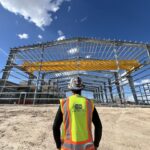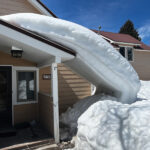It’s probably safe to say that snow guards are not the sexiest component of a building. In fact, as a contractor, you may have found yourself in the position of having to convince the architect and/or designer that they’re even necessary, because their aesthetic value is considered so low. Many architects want only the bare minimum of snow guards on their roofs-just keep the snow from sliding off and that’s it.
 This doesn’t, however, need to be the case. Snow guards are, in fact, capable of more than mere functionality. Two projects in Alaska are a showcase for the ways in which snow guards can enhance the look of a roof, and even be a standout feature.
This doesn’t, however, need to be the case. Snow guards are, in fact, capable of more than mere functionality. Two projects in Alaska are a showcase for the ways in which snow guards can enhance the look of a roof, and even be a standout feature.
The Alaska Center for the Performing Arts and the Anchorage Rail Station, both in Anchorage, utilize the SNOBAR system manufactured by Action Manufacturing LLC, Englewood, Colo., and distributed by Riddell & Company, Inc., Englewood, and SnoBlox-SnoJax, Mechanicsburg, Pa.
The architect, Kumin Associates Inc., Anchorage, specified the SNOBAR system because it could be curved to match the curves of the roofs. The performing arts center features more than three miles of snow guards, and the rail station more than a mile.
“The unique thing about both jobs is that the architect was using the snow guard not just for snow retention purposes, but for an architectural feature,” said Paul Riddell, president of Riddell
& Co. “That’s the unique aspect of these two projects; taking snow guards a step further as an architectural feature by incorporating them into the look of the job. They didn’t need that many rows for snow retention, but they wanted them every five feet on center to create more of a grid type pattern on the roof.
 “One of the biggest complaints we hear is, ‘When you put a snow guard on our roof, it takes away from the buildings’ look.’ We wanted to show that it can be part of the design process.”
“One of the biggest complaints we hear is, ‘When you put a snow guard on our roof, it takes away from the buildings’ look.’ We wanted to show that it can be part of the design process.”
The SNOBAR system uses a stainless-steel clamp and bar that can be left bare as on the performing arts center, or can be painted to match the roof as on the rail station. Since the clamp is stainless steel, it is compatible with all types of metal roofs, including copper and zinc, because there is no galvanic reaction. The performing arts center features a stainless-steel, standing-seam metal roof panel and the rail station has a zinc panel. The fact that every component of the SNOBAR system can be painted to match the roof, and the ability to curve the bar, can be welcome additions to the snow guards’ primary function: preventing snow and ice from avalanching off a metal roof, preventing damage to property, injury or death, and keeping the majority of the snow up on the roof so it can gradually melt off. The stainless steel withstands weather, as well.
 “It speaks to all bar systems,” Riddell said. “Architects can consider how to incorporate snow retention into the look of a building.” Still, Riddell stressed that safety and proper design remain the number one priority.
“It speaks to all bar systems,” Riddell said. “Architects can consider how to incorporate snow retention into the look of a building.” Still, Riddell stressed that safety and proper design remain the number one priority.
“We’ve seen the risk of just using limited snow guards. So many times people say that snow guards are unattractive, so they just want to use a small bar system over the entryway. They put one bar over the door, and we’ve seen time and time again where that single bar will fail, because they don’t design the project with multiple rows of bars. With these two projects in Alaska we want to change the architect’s perspective to look at snow retention in a different light,” he said.





